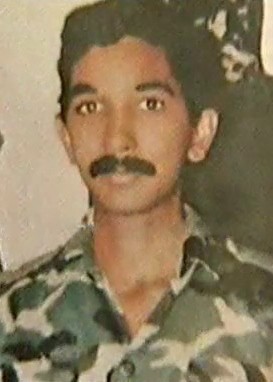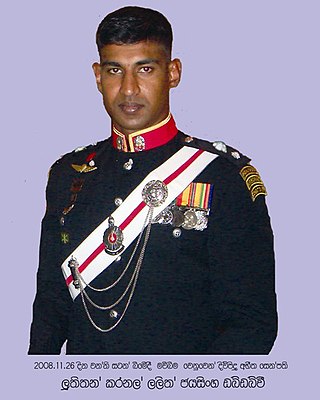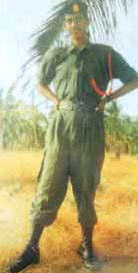
Captain Samarakoon Wasala Mudiyanselage Saliya Upul Aladeniya, PWV, SLSR was a Sri Lankan soldier and the second recipient of the Parama Weera Vibhushanaya, Sri Lanka's highest wartime award for valor. He was commanding the small army detachment at Kokavil; when it was surrounded he refused to abandon the injured and fought until they were overrun by the Liberation Tigers of Tamil Eelam (LTTE).
Eelam War III is the name given to the third phase of armed conflict between the Sri Lankan military and the separatist Liberation Tigers of Tamil Eelam (LTTE).

The Special Boat Squadron is the Sri Lanka Navy's elite special forces unit, modeled after the British Special Boat Service. It was raised in 1993.
The Battle of Mullaitivu, also known as the First Battle of Mullaitivu and codenamed Operation Unceasing Waves-1, was a battle between the militant Liberation Tigers of Tamil Eelam and the Sri Lankan military during the Sri Lankan Civil War for control of the military base in Mullaitivu in north-eastern Sri Lanka.
The Battle of Pooneryn took place between the militant Liberation Tigers of Tamil Eelam and the Sri Lankan military during the Sri Lankan Civil War for control of the military base in Pooneryn in northern Sri Lanka from 11 November to 14 November 1993.
The Battle of Kilinochchi occurred in September 1998 over the control of the city of Kilinochchi in Sri Lanka. The battle was fought between the Sri Lankan Army (SLA) and the Liberation Tigers of Tamil Eelam (LTTE).
The Northern Theatre of Eelam War IV refers to the fighting that took place in the northern province of Sri Lanka between July 2006 and May 18, 2009.
Operation Jayasikurui, was a Sri Lankan military operation launched on 13 May 1997, it lasted until 1999, when it was called off. The operation was initially launched for 6 months but cancelled after 18 months as Sri Lankan government faced huge loss. It was the largest military operation undertaken by the armed forces at the time.

Velayuthapillai Baheerathakumar was a leading member of the Liberation Tigers of Tamil Eelam (LTTE), a separatist Tamil militant organisation in Sri Lanka. He played a leading role in the LTTE's military victories in the Vanni during Eelam War III, including Mullaitivu (1996), Kilinochchi (1998), Oddusuddan (1999) and Elephant Pass (2000). He was killed at the Battle of Ananthapuram in the last days of the Sri Lankan Civil War.
The Battle of Kokavil was fought from 27 June to 11 July 1990 in Kokavil, Sri Lanka. The Sri Lankan military camp at Kokavil was put to siege by the Liberation Tigers of Tamil Eelam (LTTE) for 14 days before they captured it. Of the 54 Sri Lankan Army soldiers stationed in the base at the time, only 2 and a civilian cook reached friendly lines after the battle, with all others having been presumably killed by the LTTE.

Lieutenant Colonel J.A.L Jayasinghe PWV, WWV, RWP, RSP was a special forces officer in the Sri Lanka Army, who was posthumously awarded the Parama Weera Vibhushanaya (PWV) the highest award for combat bravery in Sri Lanka.

The Jeyanthan Regiment was an elite infantry formation of the LTTE. It was founded on 3 May 1993 and was initially trained under the leadership of Colonel Karuna Amman. It was the second oldest and most feared infantry unit of the Tamil Tigers. According to LTTE leader Velupillai Prabhakaran, the Sri Lanka Armed Forces feared the Jeyanthan Brigade the most and sought to avoid direct clashes with them. The soldiers in the unit all hailed from villages in the Eastern Province. Unlike the Charles Anthony Brigade which was only deployed in the North, the Jeyanthan Brigade was deployed in the East as well as the North and played an important role during Second Battle of Elephant Pass. The regiment was named after the LTTE's first Eastern Sea Black Tiger, Captain Jeyanthan, who destroyed a Sri Lankan Naval Patrol Vessel off the coast of Point Pedro on 4 May 1991. Prabhakaran inaugurated the unit on the 2nd death anniversary of Captain Jeyanthan in 1993.

The Battle of Kilinochchi was a land battle fought between the Sri Lankan Military and the Liberation Tigers of Tamil Eelam (LTTE) for control of the town of Kilinochchi in the Northern Theatre of Eelam War IV during the Sri Lankan civil war between November 2008 and January 2009. The town of Kilinochchi was the administrative center and de facto capital of the LTTE's proposed state of Tamil Eelam.

Lance Corporal W.I.M Seneviratne PWV, SLLI was a Sri Lankan soldier. After joining the Sri Lanka Army in 1987, Seneviratne served during the Sri Lankan Civil War. On July 4, 1996, while providing security to visiting Minister Nimal Siripala de Silva in the northern city of Jaffna, Seneviratne sacrificed his life to thwart a Tamil Tiger suicide bomber from assassinating Minister de Silva. He was posthumously awarded the Parama Weera Vibhushanaya, the highest military decoration awarded for gallantry in Sri Lanka.
The Battle of Aanandapuram was a land battle fought between the Sri Lankan Military, 58 Division, 53 Division and Task Force 8 and the Liberation Tigers of Tamil Eelam (LTTE) for the control of the last stronghold held by the LTTE. This battle is a part of the Northern Theatre of Eelam War IV during the Sri Lankan civil war. The battle was fought in the Aanandapuram area of Puthukkudiyirippu AGA Sri Lanka.
Divisions of the Liberation Tigers of Tamil Eelam refers to the military, intelligence and overseas divisions the Liberation Tigers of Tamil Eelam (LTTE). Most of these divisions were destroyed during the Eelam War IV, and only parts of the intelligence and financing divisions remain overseas.

Major Ginimalage Samantha Jayanath PWV, CR, was a major in the Sri Lanka Army and a member of the army's elite Commando Regiment. He posthumously received the Parama Weera Vibhushanaya, the country's highest military award for gallantry, for his actions during Operation Jayasikurui in the Sri Lankan Civil War.
Dissanayake Mudiyanselage Sugath Chandrasiri Bandara, PWV was a Sri Lanka Army soldier. He served with the army's elite Special Forces Regiment during Eelam War IV, the final stage of the Sri Lankan Civil War. Chandrasiri Bandara received the Parama Weera Vibhushanaya, Sri Lanka's highest military award for gallantry, for thwarting a suicide attack by the Liberation Tigers of Tamil Eelam against the army at the cost of his own life.
K. Chandana, PWV was a soldier in the Sri Lanka Army. He was part of a Long Range Reconnaissance Patrol from the army's elite Special Forces Regiment, which infiltrated deep behind territory held by the Liberation Tigers of Tamil Eelam in June 2008. He was killed in a firefight during this operation and was posthumously awarded the Parama Weera Vibhushanaya, the country's highest military award for gallantry, for his actions which enabled the rest of his team to withdraw to safety.
The Stanley Road bombing was a suicide bombing carried out by the Liberation Tigers of Tamil Eelam (LTTE) during the separatist civil war in Sri Lanka between the government and the Tamil Tigers.







